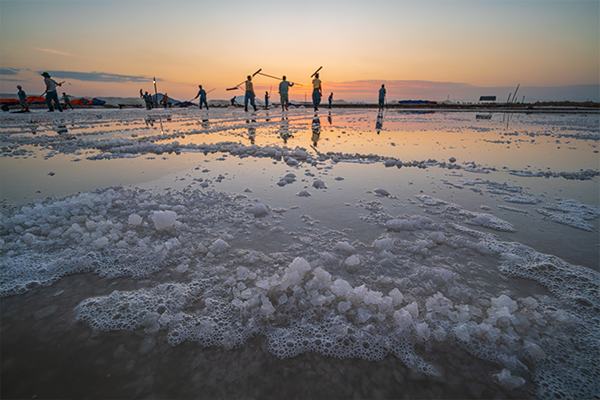If you’re a chef or accomplished home cook, you are likely well-versed in the many types of salt available for seasoning food – from table salt to exotic salts like fleur de sel. Each of these food-grade salts has vastly different textures, flavors, and uses.
Salt used for industrial purposes, such as water softening, also comes in many forms, and each type of salt has different uses based on its mineral mix and how it was harvested.
How is Salt Made?
Salt forms during the process of water evaporation. For example, our oceans have a lot of dissolved sodium in them, and salt forms from the drying seawater. Sunlight heats the ocean water, and when the water evaporates, it leaves behind elements such as sodium and chlorine. The sodium and chlorine bond together to form salt.
For every gram of salt, approximately 40 percent is sodium, and roughly 60 percent is chlorine. Purity levels of salt refer to how much sodium chloride the salt contains. For example, food-grade table salt is almost pure sodium chloride—97% or higher—with most of its impurities and trace minerals removed.

How is Salt Harvested?
There are three main ways to extract salt from seawater or underground mines, according to the European Salt Producers’ Association, including:
- Solar evaporation
- Rock salt mining
- Solution mining
Solar evaporation is when seawater evaporates in artificially created salt ponds due to sun and wind. The salt crystals formed in these ponds are harvested, washed, dried, stored, and packaged.
Rock salt mining is when salt is extracted from rock formations now located underground or inside of mountains. These underground mines of salt were still formed from an evaporation process, just one that occurred many thousands of years ago. Explosive blasts or continuing boring machines drill into the deposits and extract lumps of salt, which are then crushed into smaller pieces.
Solution mining is when water is used to flood underground rock salt deposits and force out a highly saturated brine (a mix of salt and water). This brine is pumped into collection tanks and then transported to either salt ponds for solar evaporation or to evaporation plants where a highly controlled steam heat is used to crystallize the salt.
What Types of Salt Can I Buy at the Store?
Understanding where salt comes from and how it is made will help you understand more about the types of salt you see on store shelves and which type you want to use in your water softener.
Rock Salt
Rock salt is the least processed form of salt. It is extracted during rock salt mining and crushed into smaller pieces. Its sodium chloride content is around 95% or higher, depending on the mine from which it comes. Rock salt is perfect for deicing roads but is not always ideal for water softeners because impurities like rock or shale found in the rock salt may clog or damage your water softener. While you can use rock salt, you will have to perform much more frequent cleaning inside your brine tank to remove impurities and buildup.
Solar Salt
Solar salt is salt formed through the solar evaporation process. Because solar salt is made from brine, insoluble impurities in the salt can be eliminated. Solar salt’s sodium chloride content is usually 99.5% or higher. One of the most common uses for solar salt is in water softening. Solar salt is generally sold in a crystal (sometimes called coarse) or pellet form.
Evaporated Salt
While all salt is formed through an evaporation process, salt marketed as evaporated salt is salt that was processed inside of an evaporation plant, using heated steam rather than the sun to evaporate the water and leave behind the salt. This type of salt is generally of the highest purity (99.9%) and is typically the most expensive type of salt you can buy. Evaporated salt is usually sold in a pellet form.
Crystal- or Pellet-Size?
As we said before, solar salt usually comes in two forms, either crystal or pellet. Crystals are smaller in size than pellets and are generally recommended for households with below-average water consumption or for water softeners that use a twin tank system.
The pellet form of salt is larger in size and is recommended for households with high water usage or for water softeners that only have a single tank. Why? The larger size of the pellet helps prevent bridging.
Bridging occurs when a layer or crust of hardened salt builds up at the top of the brine tanks and creates a space between the salt and the water, preventing water from getting softened. Solar salt and evaporated salt are both sold in pellet-size form.
Generally, the manufacturer’s instructions will indicate if a pellet- or crystal-sized salt is preferred.
Advantage Salt
Your Advantage Salt Supply pros recommend solar salt for use in your water softener, and we offer bags, pallets, and bulk salt deliveries for residential and commercial customers. Solar salt in your water softener minimizes waste accumulation in the brine tank and is most cost-effective.
We also provide solar salt with rust-out for use in your water softener, which is a salt mixture specially formulated for water containing iron.
For more information on what type of softening salt is the best choice for your needs, contact one of our Advantage Salt Supply experts.





